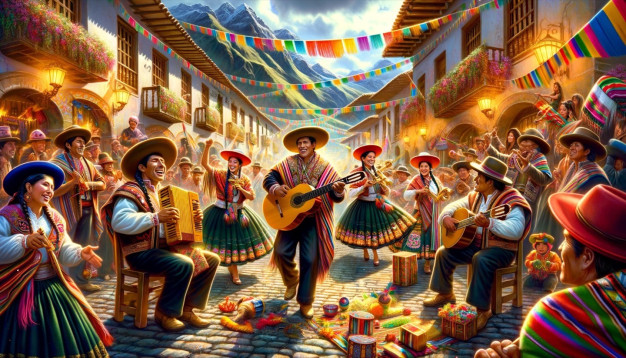
Imagine a land where the melodies of the past harmoniously dance with the beats of the present. A land where every chord and step narrates a tale as old as time. Welcome to Peru, a country that has seamlessly woven its ancient traditions with modern influences to create a vibrant tapestry of music and dance.
An Introduction to the Vibrancy of Peruvian Culture
Have you ever wondered how a country’s history can influence its music and dance? Peru is a perfect example of this. From the majestic Andean peaks to the swaying palm trees of its coasts, each region has contributed to the rich musical landscape of the nation. It’s truly a testament to how diverse heritages can come together and create something mesmerizing.
A Brief History: Tracing the Origins
Before we dive into the melodic depths of Peruvian culture, let’s take a quick journey back in time. Did you know that the music and dance styles of Peru have roots in pre-Inca civilizations? Indeed, these ancient societies had their own unique musical practices.
Then came the powerful Incan empire. While they left an indelible mark on architecture and culture, their influence on music and dance was equally profound. But history didn’t stop there. With the Spanish colonization, Peru saw an influx of new instruments and styles. This mix of indigenous and European elements gave birth to contemporary styles post-independence.
Instruments That Sing the Peruvian Tale
Peruvian music is like a palette of vibrant colors, and the instruments are the brushes that paint this canvas. Ever heard the enchanting sound of the Charango? Often likened to the Andean mandolin, this instrument has a distinct resonance that’s unmistakably Peruvian.
Then there’s the Cajón. Originating from the African slaves brought to Peru, this box-like percussion instrument is now synonymous with Afro-Peruvian rhythms. The Cajón has even found its way into flamenco music in Spain! But can you guess the secret behind its pulsating beats? It’s all in the hands of the musician.
Let’s not forget the hauntingly beautiful sounds of the Zampoña (pan flute) and the Quena (flute). These instruments, deep-rooted in Peru’s history, add an ethereal quality to the music.
Dances that Tell a Story
Dance is not just a form of expression in Peru; it’s a storytelling medium. Ever witnessed the graceful moves of Marinera? This coastal dance, with its flirtatious and elegant moves, is a visual treat. But here’s a question for you: Can you guess what makes it unique? It’s the beautiful interplay between a male and a female dancer, symbolizing courtship.
Travel to the highlands, and you’ll encounter the Huayno. With rapid footwork and colorful attire, it’s a dance of love and courtship. Meanwhile, the Festejo is a jubilant celebration of Afro-Peruvian heritage and freedom. And for those seeking something truly awe-inspiring, the Danza de las Tijeras or scissor dance, where dancers perform breathtaking acrobatics with scissors in hand, is a must-see.
Regional Variations: From the Mountains to the Coast
Peru’s diverse landscapes have led to equally diverse musical styles. The coast, with its blend of Spanish, African, and indigenous influences, offers a unique sonic experience. On the other hand, the Andean highlands resonate with tradition and spirituality. Ever felt the call of the wild? The untamed rhythms of the Amazon jungle will surely captivate you.
Contemporary Music: A Fusion Like No Other
Modern Peruvian music is a testament to the nation’s ability to innovate while staying true to its roots. The rise of Chicha music, a psychedelic form of cumbia, showcases this beautifully. With its urban appeal, it’s a hit among the younger generations. But it’s not just about Chicha. Peruvian rock, pop, and even electronic music, while influenced by international genres, have a distinct Peruvian flavor.
Celebrations and Festivals: Where Music and Dance Come Alive
No discussion of Peruvian music and dance would be complete without mentioning the vibrant festivals. The Inti Raymi or festival of the sun is a spectacle where ancient Incan traditions come to life. Puno’s Candelaria festival, on the other hand, is a dance extravaganza like no other. And then there’s the Fiesta de la Virgen del Carmen, a perfect blend of religious devotion and festive dance.
The Global Stage: Peru’s Influence Beyond Borders
Peruvian music and dance haven’t just remained within the country’s borders. They’ve enchanted audiences worldwide. From international music festivals to dance shows, the world has sat up and taken notice. Artists and groups have played pivotal roles in taking this rich culture to global audiences. But why do you think this is the case? Is it the authenticity, the passion, or simply the irresistible rhythms?
The Future: Young Artists and New Sounds
As we look to the future, the next generation of artists is redefining Peruvian music and dance. While they respect and draw inspiration from traditional forms, they’re not afraid to experiment. With innovations and fresh takes on age-old styles, it’s an exciting time for the Peruvian music scene.
Wrapping It Up: A Living Legacy
Peru’s musical journey is an ongoing one. With each passing day, new notes are added to this symphony, ensuring that the legacy remains alive and thriving. For those of us fortunate enough to experience it, it’s a reminder of the power of music and dance to transcend borders, touch souls, and bring people together. So, when are you planning your musical journey to Peru?